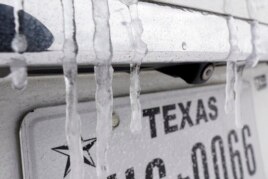19 February 2021
Many places across the United States have faced extremely cold and dangerous winter weather in recent days. This includes states like Texas and Oklahoma, where such severe winter storms are uncommon.
The lack of planning and preparation by leaders in those areas left locals without heat, water, gasoline and other critical services for many days. At least 20 people have died this week.
Experts warn that deadly weather will be hitting the U.S. more often, and that the country needs to get better at dealing with it.
This week's storms fit a pattern of worsening extremes under climate change. They also demonstrate that local, state and federal officials have failed to do enough to prepare communities for extreme and dangerous weather.

Icicles hang on the back of a vehicle Monday, Feb. 15, 2021, in Houston.
"This is a different kind of storm,″ said Kendra Clements. She is one of several businesspeople in Oklahoma City who opened their buildings to shelter homeless people. Some of them came in with frostbite, hypothermia and ice in their hair.
The storms served as a predictor of what social service providers and governments say will be increasing needs among the nation's poorest people as climate and natural disasters worsen.
Other Americans are at risk as well. Power supplies of all kinds failed in the extreme cold, including natural gas-fired power plants that went offline in icy conditions. Some wind turbines froze and stopped working.
The crisis has raised concern for power systems throughout the country. As climate change worsens, such severe conditions will become more common.
Sara Eftekharnejad is a professor of electrical engineering and computer science at Syracuse University in New York. She called the week's storms "an anomaly," or unusual and unexpected. But such anomalies, she said, are likely to happen more often as a result of climate change.
"There probably needs to be better planning, because we're starting to see more extreme weather events across the country," she said. That could be in the form of severe cold like in Texas or intense heat waves like the one California experienced last year that fueled deadly wildfires.
Michael Craig is a professor of energy systems at the University of Michigan. He said the events in California and Texas show that "what we have now is not going to do it in the face of climate change. It's only going to get worse from here."
In Texas, wind power is a growing source of electricity. But most wind turbines operating there are not designed for very cold weather. Making small changes to wind turbines is one step needed to deal with climate change, said Roy McCann. He teaches electrical engineering at the University of Arkansas.
Some Republican politicians, including Texas Governor Greg Abbott, have tried to blame wind and solar power for the massive outages. However, traditional power plants, which depend mostly on natural gas, provide the majority of power in Texas. They were the larger problem.
Joshua Rhodes is a researcher on energy issues at the University of Texas. "The entire system," he said, "was overwhelmed."
I'm Ashley Thompson.
The Associated Press reported this story. Ashley Thompson adapted it for VOA Learning English. Caty Weaver was the editor.
_____________________________________________________________
Words in This Story
pattern - n. something that happens in a regular and repeated way
frostbite - n. a condition in which part of your body (such as your fingers or toes) freezes or almost freezes
hypothermia - n. a condition in which the temperature of your body is very low
(wind) turbine - n. a tall structure that has large blades attached to an engine and that is used to produce electricity